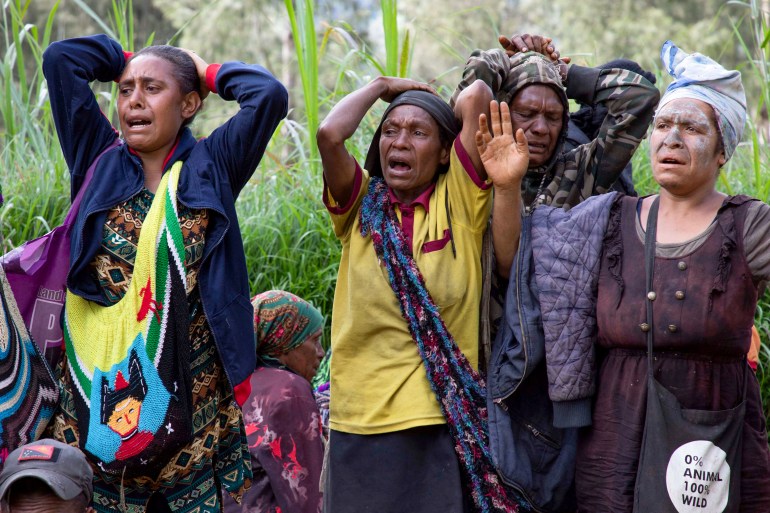Hopes are fading that an estimated 2,000 people buried by a landslide in Papua New Guinea’s Enga province will be found alive, a United Nations official has said.
“It is not a rescue mission, it is a recovery mission,” UNICEF Papua New Guinea’s Niels Kraaier said. “It is very unlikely they will have survived.”
The UN’s children’s agency later said about 40 percent of those affected were children under the age of 16 who had been “deeply traumatised” by what had happened, and that it was intensifying its relief efforts.
Rescue efforts at the site of the landslide on Mount Mungalo have been led by local residents, many of whom lost their entire families in the landslide, which wiped out an entire hillside community at about 3am on Friday (18:00 GMT on Thursday).
A couple survived the calamity in “a miracle”. Only six bodies have been recovered, while Papua New Guinea’s National Disaster Centre estimates as many as 2,000 people have yet to be found.
The landslide also wiped out vegetable gardens and roads, hampering rescue efforts and leaving villagers worried about finding enough to eat, as they search for their loved ones.
“People are digging with their hands and fingers,” Enga provincial administrator Sandis Tsaka told the AFP news agency on Tuesday.
“Entire families” were “buried under debris”, said Tsaka, adding that the hillside community of homes, businesses, churches and schools had been “completely wiped out”.
“It is the surface of the moon. It is just rocks,” he said.
“I have 18 family members buried under the soil that I’m standing on,” said Evit Kambu, a resident of the village.
Fears are also growing for nearby villages as the ground continues to shift.
“Every hour you can hear rock breaking – it is like a bomb or gunshot and the rocks keep falling down,” Tsaka said.
Local authorities are now trying to evacuate 7,900 people to avoid any further loss of life, he added.
Tsaka spoke at an emergency online meeting organised by the UN with foreign governments on Tuesday morning and asked for immediate assistance to deal with the landslide risks, manage the response and ensure the rapid delivery of supplies.
He acknowledged that PNG, one of the Asia Pacific’s poorest countries, was not equipped to deal with the scale of the tragedy.
It is unclear how many people were living in the hillside community in dense tropical rainforest when the landslide hit.
The last official census was 24 years ago.
The population of the small roadside community had reportedly swelled in recent months and years, Glenn Banks, professor of geography at Te Kunenga Ki Purehuroa: Massey University in New Zealand, told Al Jazeera.
People had moved to the area in the hopes of finding gold in the open pit and waste dumps of the nearby Porgera gold mine, said Banks, whose research focuses on mining in Papua New Guinea.

He added that the mine was about 20-30km (12-19 miles) from the landslide, meaning that it had had “a direct effect” on “the stability of the ground along the road”.
The number of people living in the area may also have grown after dozens of people were killed in tribal fighting in February, Banks noted.
More than 25,000 people have been displaced by tribal fighting in Enga province, according to the International Organization for Migration (IOM), including at least 5,453 people displaced in February and March this year alone.
Landslides becoming more common
Enga province is one of several mountainous highlands regions in PNG that form part of the third largest rainforest on earth after the Amazon and the Congo Basin rainforest.
Papua New Guineans, who have long grown yams, cassava, bananas, and taro in the mountains, are increasingly having to contend with a changing climate as well as logging and forest clearance by international mining, timber and palm oil companies.
The tropical forests’ dense trees helped to prevent landslides because their roots held the soil together, said Alan Collins, professor of geology at The University of Adelaide.
“Deforestation can make landslides more prevalent by destroying this biological mesh,” he said.
Rainfall can also weaken rocks and can destabilise the ground, Collins added.
Papua New Guinea is ranked as the world’s 16th most at-risk country to climate change and natural hazards, according to the 2022 World Risk Index, even though it is only responsible for about 0.11 percent of global greenhouse gas emissions.

The mountains in Enga province are also unstable due to their proximity to the edges of the Australian and Pacific continental plates, Collins added.
“Although this landslide does not appear to have been directly triggered by an earthquake, the frequent earthquakes caused by plates colliding build steep slopes and high mountains that can become very unstable,” he said.
Read More: World News | Entertainment News | Celeb News
Aljazera







